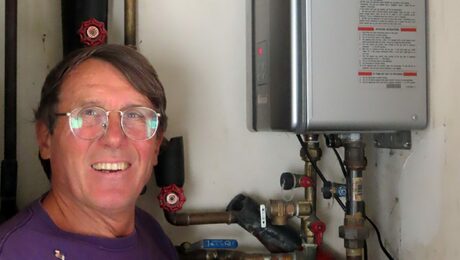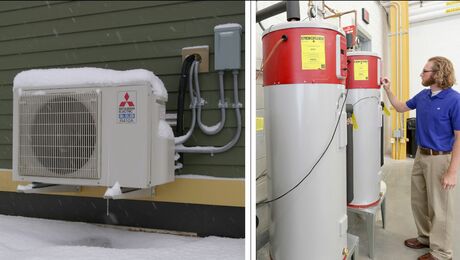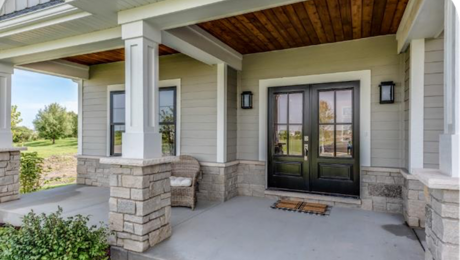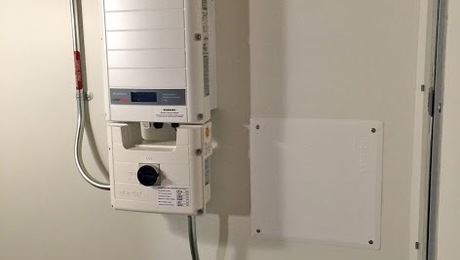Fujitsu vs. Mitsubishi Minisplits
My understanding has always been that Mitsubishi and Fujitsu ductless units are roughly comparable, though the Mitsubishi units are considered to have a slight edge in reliability and a larger distributor/service network in the US. I haven’t really paid much attention to the Fujitsu units’ specs since in my area there are way more Mitsubishi diamond contractors than there are Fujitsu elite contractors (or whatever they’re called). But I just started comparing the specs on some of the Fujitsu Halcyon units to the Mitsubishi h2i ones and I was surprised to learn that 1.) the Fujitsu units are notably more efficient (a COP of 5+ at 47F, compared to 4-4.5ish for the Mitsubishi units), and 2.) the Fujitsu units put out significantly more btu’s at low ambient temps than their Mitsubishi counterparts. Do I have this right? Am I missing something?
For example, the “9,000 btu” units. Here are some of the Fujitsu Halcyon specs:
Outdoor unit: AOUG09LZAS1
Indoor unit: ASUG09LZBS
SEER: 33.1
Heating 5F max: 15,400
Heating 17F max: 16,000
Heating 47F rated: 12,000
Heating 47F max: 22,000
Heating 47F COP at rated output: 5.33
And here is the Mitsubishi h2i:
Outdoor unit: MUZ-FS09NA
Indoor unit: MSZ-FS09NA
SEER: 30.5
Heating at 5F: 11,590
Heating at 17F: 14,170
Heating at 47F rated: 9,600
Heating at 47F max: 18,000
Heating 47F COP at rated output: 4.54
The Fujitsu unit has the Mitsubishi one beat in every single one of these categories. And they cost roughly the same (at least they do online). So what gives?
I find the 47F COP numbers particularly interesting. Because if the heat load for a cold climate, nine-month heating season house requires 25,000 kwh of electric resistance baseboard heat, and if the average temp in your area over those 9 months is at or close to 47F, then a rough estimate of your kwh usage by switching to either Fujitsu halcyon or Mitsubishi h2i 9k btu wall units would be 25,000/5.33 = 4,690 kwh (Fujitsu), or 25,000/4.54 = 5,507 kwh (Mitsubishi). This is not an insignificant difference, especially if you have high electric rates (20-30 cents per kwh in some areas).
So it would seem that if the above specs are what’s most important to you, Fujitsu is the obvious choice. Am I thinking about this correctly? Of course, it should be noted that the 9k Mitsubishi units modulate down to lower minimum outputs than the 9k Fujitsu ones – the Mitsubishi ones go down to significantly lower minimums than the Fujitsu units at all the benchmark temps: 5 F, 17F, 47F, 80F (cooling), and 95F (cooling). But if your loads at all these temps are not lower than the Fujitsu unit’s minimum output, then this wouldn’t matter, and the Fujitsu would still be the one to go with. No?
GBA Detail Library
A collection of one thousand construction details organized by climate and house part









Replies
The Fujitsu units have a higher heating capacity per nominal rating across the board. They also have an awesome 9k, 12k, 18k slim duct lineup. I think you would be happy with either manufacturer. I would focus on finding an installer you trust. Quality of installation and support in the future will likely be much more valuable than half a COP. Also those numbers are measured at very specific operating conditions, i would use them directionally more than anything else.
I wish I could say I've found an installer I trust, but I honestly don't trust anyone I've met with so far. I got estimates from six Mitsubishi diamond contractors and ran into a lot of the same problems already documented on this site: quoting close to $20K for three wall units; massively oversizing the proposed systems; aggressive upselling of multi-floor $35K systems; insisting that it would be fine to put air handlers and ductwork in our unconditioned attic; insisting on multi-split systems; proposing to put four wall units in a single 700 sq ft space; hostility to using a Manual J as a basis for sizing; a lot of talk of treating me like "family" and being able to "look me in the eye" but then turning around and looking me in the eye while trying to sell me on the idea of putting one 6K wall unit in each of our three tiny bedrooms; one guy tried to sell me a 70,000 btu multi-split system for our 30,000 btuh load. It really just reminds me of dealing with the hostility and contempt and ignorance I've encountered at Nissan dealerships when purchasing both our Leafs over the years. I mean, I'm no expert on this stuff - I'm the opposite of an expert - but very little of anything these diamond dealers say to me checks out with any of the green building theory that one can find on sites like GBA. So honestly, I've lately been considering just hiring a handyman to install a bunch of DIY Mr Cool units and be done with it. If I did that, I could heat the whole house for under $5K. Yeah, they may fail in a few years but at least the labor costs on fixing/replacing them aren't astronomical. Part of the problem I'm having with spending $15-18K on three Mitsubishi or Fujitsu mini-splits is that, sure, the $1500 units are warrantied for 12 years if you use an elite/diamond contractor, but those contractors charge about $1,000/hour for their installation labor, so imagine what they'll charge you to take out a broken one and then replace it with a repaired one. The whole 12-year relationship just seems like a money pit. But I'd love to be wrong about that. Because the units themselves seem fantastic. What I may do is buy just one Mitsubishi or Fujitsu unit from a local dealer (like one 12K or 15K unit for the first floor) and then add 1-2 DIY Mr Cool units at a later date.
Some of the Mitsu, Fujitsu, and others (even mr cool non-DIY) can be found online. If you're somewhat technically savvy and willing to study a bit, you can probably get your EPA 608 card. Add a vacuum pump & gauge, flare tool, torque wrenches, and you could probably just install whatever you want by yourself . No warranty, but looking at some of those prices you could buy two whole units and all the tools and still come out ahead!
So I had the same experience. I ended up installing a ductless Fujitsu unit for my first floor on my own as well as a ducted unit for the upstairs. I found a local one man hvac contractor to pressure test and vacuum the line sets for me. I bought the units online so no parts warranty, but you are right. When you can buy a whole new unit for $2k, it sure beats paying ridiculous labor costs.
I’ve heard about people doing that, but I’ve also heard it can be hard to find an hvac company willing to do that work. Any tips about how to go about that? Did you have the hvac company lined up before you bought and installed the units?
Something you might consider is contacting a local tech college with a good reputation and inquiring if they are in need of demo installations for their HVAC students.
This would likely take longer and be more disruptive than a professional install and would not carry a warranty, but the students would be trained with best practices and not have financial incentives to cut corners. There would also be adult supervision.
Even if the school is uninterested, you might find faculty willing to take on side work, or even just want to stay current on new technology.
Just curious, but what part of the country are you in? I am having the EXACT same experience as you in SW New Hampshire, and I have also been considering getting a handyman and electrician to help me install a few Mr. Cool DIYs. One installer was so offended when I politely requested a detailed load calculation instead of his quick eyeball estimate, he raised his voice and said "if you don't like the way we do it, go find someone else to do it" and hung up on me.
I’m in southern CT, Fairfield County, but not one of the wealthy towns. I imagine this is happening in a lot of places in the US - my sense is the hvac industry is accustomed to making $20k per house when they install AC somewhere, so they’re determined to make their money one way or the other, and that math only works on mini-split installs if they mystify the complexity of their installation labor. Because my understanding is that it only takes them 4-6 hours to to install one mini-split?
The Mr Cool DIYs look like a solid choice - the 18k btu unit still puts out around 13,000 btuh at my 99% design temp (11F), and they have a COP of around 4 at my average winter temps (47F). Not bad for something you can buy at Home Depot. One thing you might try is a Mr Cool DIY or two plus one Mitsubishi or Fujitsu unit from a more humble, smaller, non-elite/diamond hvac contractor and see if you get a more reasonable price. That’s what I’m planning to do.
I'm in Southern CT on the shoreline near New Haven. After getting ridiculous pricing as well I self installed a 12k Midea Premier and a 12k Gree Sapphire. Both are Hyperheat Units and the Midea was $1k and the Gree was $1300. I am a former auto mechanic and found the install simple and took like 4 or 5 hours. Total cost with some tools and other pieces for me to install the was less than $3k. All the installers around here wanted $10k+ for 2 12k units. I could buy 5 or 6 more entire units and still be ahead. In most of the world these are cheap disposable appliances. If my compressor goes I am just buying an entire new outdoor unit for a few hundred. The warranty from Mitsubishi is the part only. Its not cheap to have to pay HVAC labor. So if your compressor on your Mitsubishi goes they will send you a compressor but your paying the labor to replace it.
My Midea and Gree have been running for 3 years nonstop with zero issues. Midea and Gree actually make most of the mini splits out there. Mr Cool and Carrier, Pioneer, Senville are all rebadged Mideas.
That Mr Cool unit would probably work fine in your location. I would buy it from Costco as they sell them and have a grest warranty/return policy.
I sympathize, man, I really do. When I had a new system installed, I experienced the same thing.
Also, you are absolutely right that, in many cases, a 10 or 12 year warranty is a complete sham. I paid about $10k for a Trane XV18. At the 3 year mark, the evaporator coil developed a leak and was replaced "under warranty." Well, sure, I didn't pay for the coil itself, but you know what I did pay? $1500 for labor, and another $1000 to replace 10 lbs of refrigerant with new refrigerant. So $2500 for an evaporator coil replacement "under warranty." For a system I paid $10k for less than 3 years ago. Wonderful.
For the record, I don't blame the company that did the replacement work. They were great and obviously somebody has to pay them for the 6 hours they were here doing the replacement. I've just learned its very misleading to think you have a 10 year warranty on something, but the labor and other non-warranty costs (like refrigerant) which make up 75% or more of the repair costs are not covered. Makes the warranty almost worthless.
I had planned to purchase a Mitsubishi MUZ-FS12NAH to replace one of our current mini-splits, but ruled it out due to the way that the pan heater operates. As I understand it, the pan heater which draws 130-watts kicks on whenever ambient air temperatures fall below 0°C, and remains on until it climbs back above freezing. Other manufacturers offer a more intelligent control system whereby it engages whenever the unit enters defrost mode, and shuts off five or ten minutes thereafter. In our local climate, this would reduce our home's energy requirements by 300 or so kWh per annum.
Hopefully, someone will correct me if I'm wrong in this. I had contacted Mitsubishi's customer support group to verify my understanding, but never received a reply.
I highly doubt the pan heater stays on. I have monitored the electrical consumption on many mini splits of different brands and have never seen a pan heater stay on like that. Hyper heat units do have a compressor warmer that comes on but they usually use less than 30 watts.
I'm not sure how to correctly interpret what is described in the NEEP entry for this model, but it states:
"A.) Heat mode is selected. B.) The ambient temperature thermistor reads 32F or less for 5 minutes continuously. C.) The defrost thermistor reads 30.2F or less for 5 minutes. D.) Outdoor fan motor is turned ON."
With that said, the MUZ-FS12NAH has an HSPF rating of 11.5 versus 12.0 for the MUZ-FS12NA, which is, I believe, the identical model without a pan heater. If my thinking is correct, that translates to be a seasonal COP of 3.37 for the NAH as opposed to 3.52 for the NA, which means that the former consumes roughly four to five per cent more energy over the course of the space heating season, all of which can be presumably attributed to the operation of the pan heater.
By comparison, the Fujitsu AOUG12LZAH1 and AOUG12LZAS1, which are, from all outward appearances, the same model with and without a pan heater, clocks in at 13.8 and 14.0 respectively, a much smaller difference in the order of one and a half per cent.
Again, I may talking through my hat here, but it appears that the Mitsubishi pan heater logic is less than optimum.
did you ever figure out if the pan heater is always on when temp is <32 degrees? or do those A, B, C, D statements operate together and its smarter than that?
That's not encouraging. Keep us posted if you find anything out. Thanks for the tip.
We went with Fujitsu ducted and ductless due to their efficient heat output plus having the ability to vertically mount the indoor unit. We're in a heating dominant climate and only run the air conditioning 3-5 weeks per year. The Mitsubishi had a nice inline filter that could be purchased for their ducted. Our HVAC installer had it replicated at the sheet metal shop to fit the Fujitsu return air intake.
Just a quick update on this. I ended up going with a smaller Fujitsu installer who charged me $7K total after rebates for two one-to-one ductless wall units - one 15K, one 9K, both Halcyon hyper heat. I went with the ones that go down to negative 5F instead of negative 15F because we already have a backup heat source for truly crazy cold weather (radiators) and the COP on the negative 5F units at almost every meaningful temp (5F, 17F, 47F) is significantly better (5 vs 4 at 47F). The install was flawless with no issues or drama. We're very happy with the units. The 15K unit in particular heats most of our first floor (kitchen, dining room, living room) to 70 F, as well as our upstairs bedrooms to 65F. I guess the trick to getting more reasonable pricing is finding smaller hvac shops - or maybe I just lucked out that this guy had a lot of experience with Fujitsu ductless units in particular and that his quote was thousands below the competition. All the other elite/diamond Mitsubishi and Fujitsu dealers wanted $12-15K for two units. So I thought $7K for two units was very reasonable - he even did the electrical work too. In fact, if I had hired a handyman and electrician to install two Mr Cool DIY units, after materials and labor the cost wouldn't have been that different. Anyway, I've only had these units in for ten days or so, but so far, they're outstanding.
Hi. Sorry to jump on an old thread
I noticed you installed ASUG09LZBS indoor unit. Does it have Wi-Fi?
Thank you